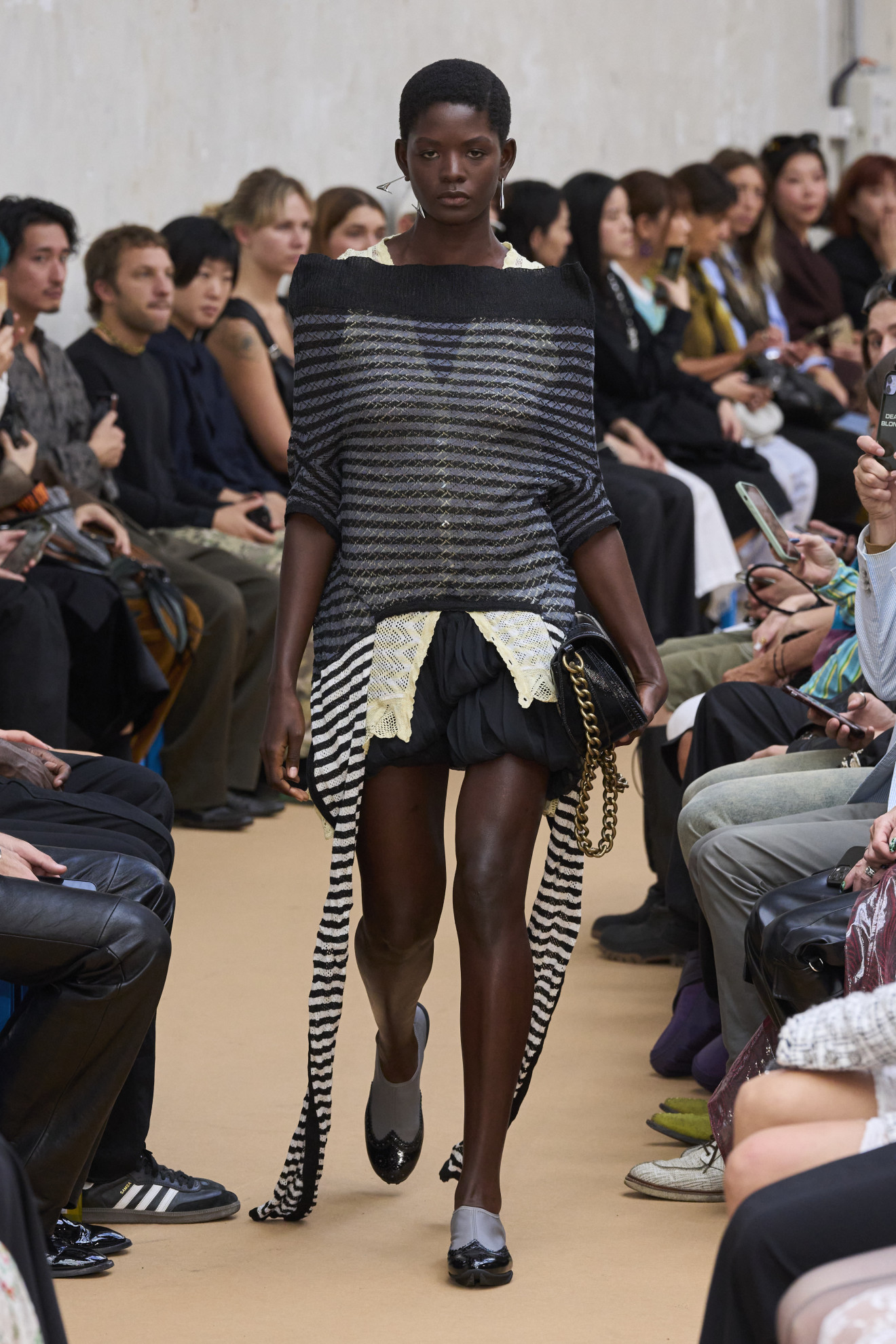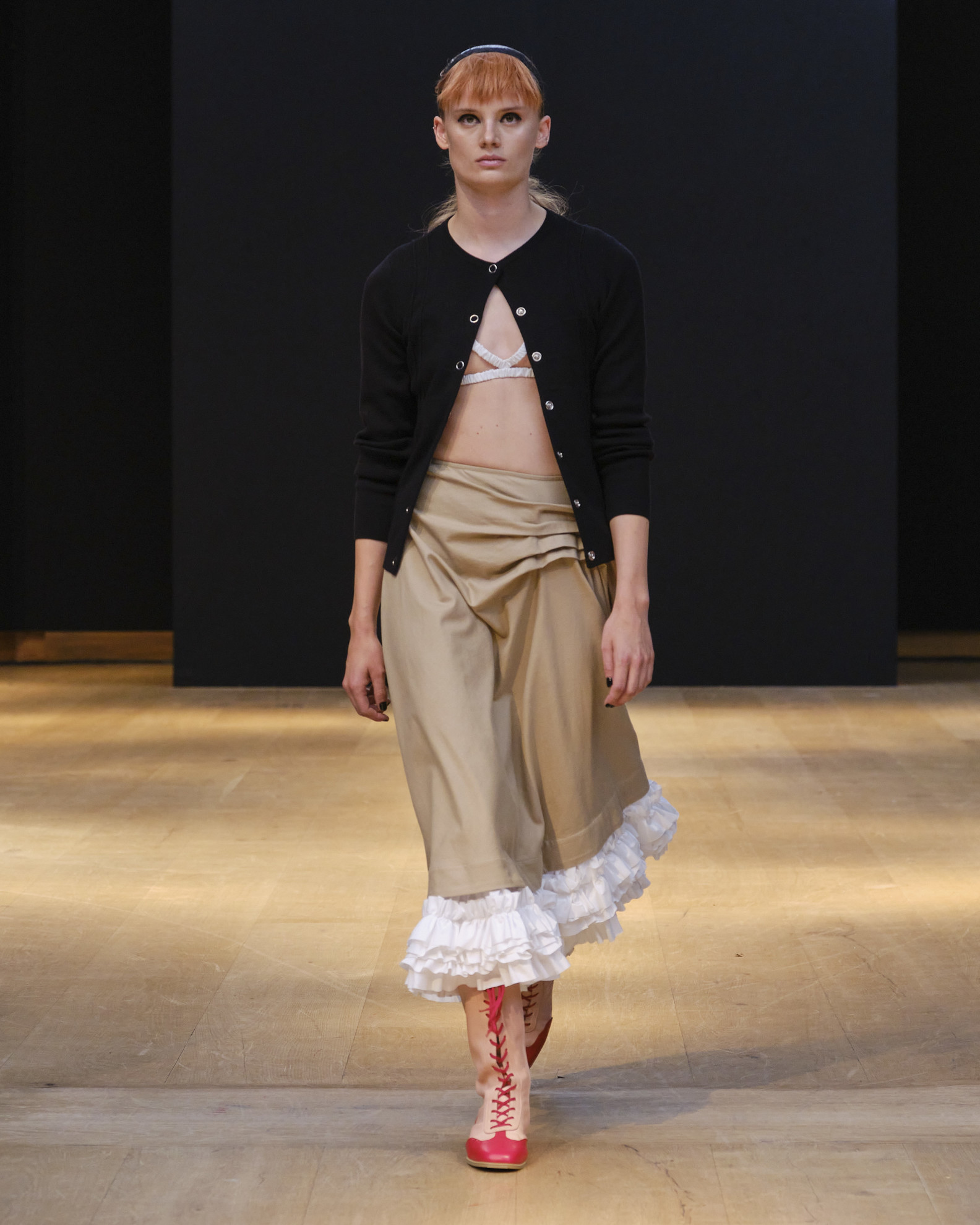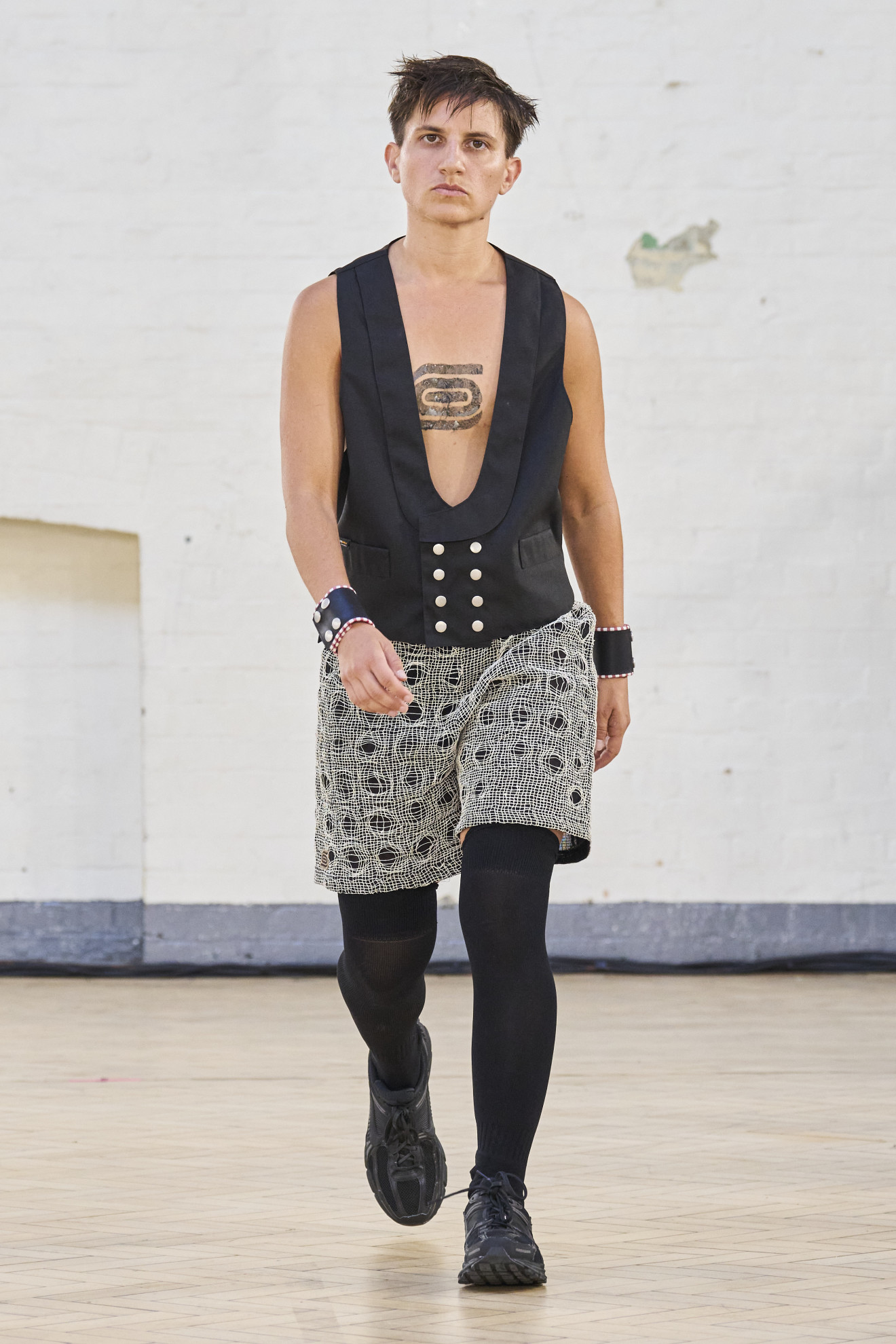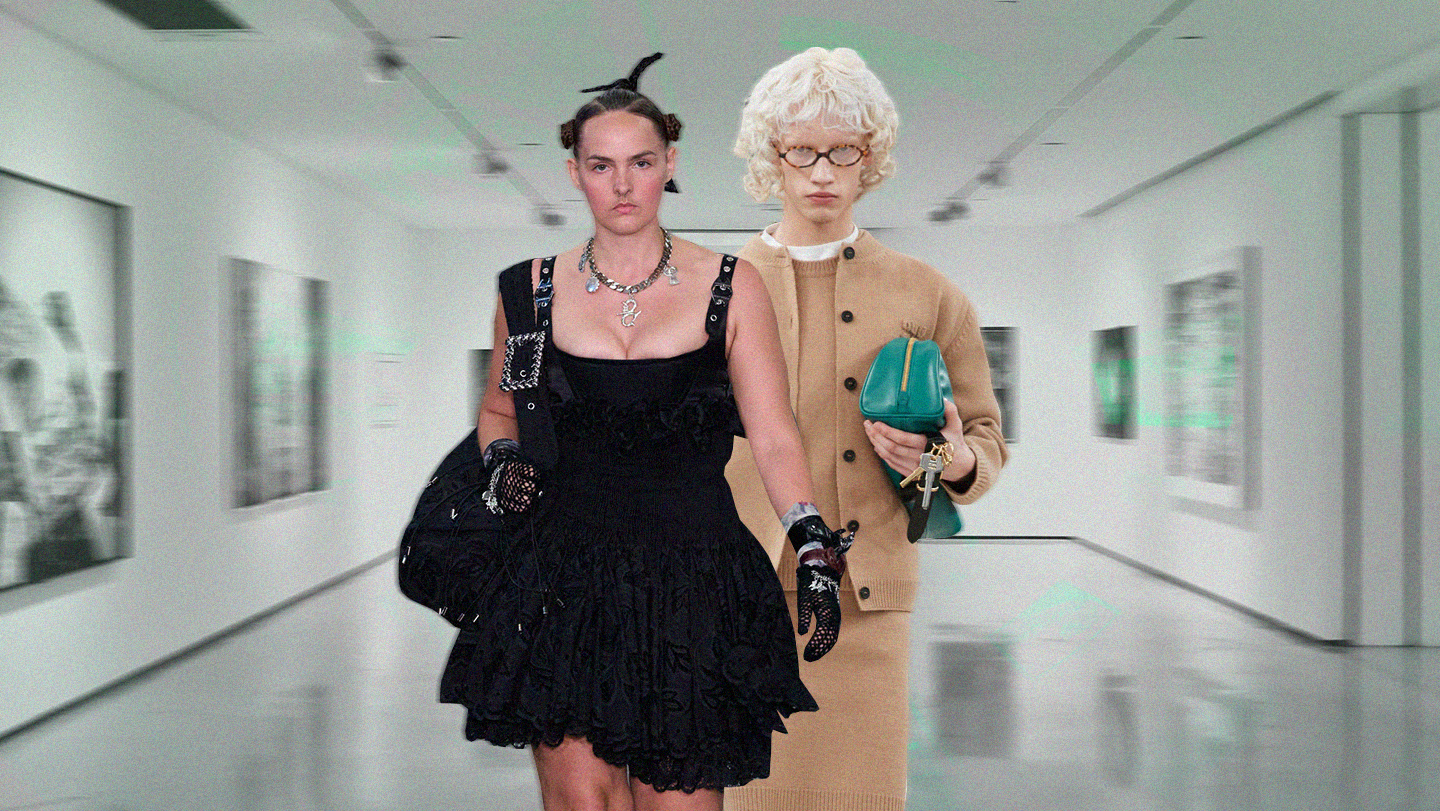Aside from Fashion Month itself, there are few places as sartorially on the pulse as the art world. But with competition rising in the past few years, it’s become a whole new arena. From Frieze, Paris+ and Art Basel Miami Beach to the baby galleries cropping up across London, New York and beyond, an unforeseen style revolution is underway, with many of the art world’s movers and shakers flexing an increasingly choice coterie of niche designers and archival greats.
Yes, the original ‘gallerina’, once renowned for her haughty ways, Old Celine and Prada skirts, has lost her title as fine art’s best-dressed gatekeeper. Back in the day, she used strong, clean lines and household-name designer credentials to hold the fort on the gallery’s front desk, primed with a ball-busting attitude that could make any low-level collector quake in their Loro Piana desert boots. However, now, this archetype – embodied by Sex and the City’s Charlotte York – has lost its cool.

Anyone looking to make their name at the auction houses and art fairs these days needs a little more panache. Enter: the gallerina 2.0, a resolutely millennial, if not Gen-Z, character, assured in their sense of style and unwilling to tone it down for any gouty patron. Instead, she, or they, helms their very own micro-institution from a former sandwich shop, working with a stable of artists whose practices are difficult (visually and commercially), rocking the likes of a Chopova Lowena skirt, Kiko Kostadinov ballet flats and a vintage Balenciaga City bag – bought before the craze, they’ll tell you. Well, that’s one iteration. Rather than being tied to a single look, the contemporary gallerin(a/x) is defined by their esoteric, bleeding-edge taste, just as at home in Dumbo House and Groucho as they are in a wretched techno squat party.
Take, for example, Claire Sammut, a director for Maxwell Graham’s blue-chip gallery, nestled between New York’s Chinatown and the Lower East Side. Clad in archival Yohji Yamamoto (all black, naturally), she cuts quite the dash, finishing her looks with leggy black leather boots, plus a slew of Y2K treasures and ironic OG gallerina classics. “An Emanuel Ungaro wool cardigan with shoulder pads, old Manolos that need to be resoled and a Chloé Silverado [the Paddington’s cursed cousin] held together with a zip tie,” she confirms. It’s a little chaotic, but this meticulous mining of pre-millennium style and IYKYK pieces feels much more in keeping with a cost-of-living crisis, especially, if like Claire, you work in an infamously precarious industry.
Similarly, Helen Neven, the founder of newly opened Neven Gallery in east London, embraces a little chaos, teaming an amorphous and hilariously named ‘Bitch Bag’, designed by her bestie, designer Luis De Javier, with block-heel boots and a statement leather coat that’s carried her through many a weekend in Berlin. Sometimes, she’s her own gallery’s biggest mascot, wearing hyper-cutesy designs from artists she represents. “I rarely go a week without donning my silver bow necklace by Leo Costelloe,” she says. Helen does, however, pay homage to the Old World gallerina, via what she dubs ‘Miu Miu-core’. Think pencil skirts, button-downs and crew necks to confirm your professionalism, exaggerated slightly, or geeked out with some noughties clear-lens glasses. Together, it’s a little bit mumsy, a little bit techno, but still commanding, ideal for a day nursing artists’ egos, dull contractor meetings and roadblock openings.

Another hot young thing making waves, Rose Easton runs her eponymous gallery, supporting artists with avant-garde practices. Having once worked as the creative director of Phoebe English, working with the brand between 2011 and 2013, Rose later left the rag trade behind and began working in galleries, although her proximity to the hotbed of brands in London meant her studied knowledge of fashion stayed. Indeed, her gallery is next door to Molly Goddard’s studio, so Rose is often wearing Molly to openings, if not something a little kookier, like the white vinyl Courrèges boots and Coperni suit Rose sported to her wedding, styled by Celestine Cooney. “Phoebe English is my forever clothing of choice – Japanese design and Phoebe forever,” Rose says. “Mostly it’s white shirts and black trousers, but I do low-key enjoy cosplaying the artwork, gearing my outfits to compliment the show.” As such, Rose, the modern-day art goth, has been seen out and about wearing the very wares of Kendrick Lamar-approved artist Arlette, just shown at Rose Easton gallery. And while monochrome is nothing new for the old-school gallerina, Rose’s Wednesday Addams-level gothicism is.
Perhaps, what makes this stylistic shift among the art world’s front-of-house so pivotal is that, until recently, it was the artists, and the artists only, who would showcase their weird and wonderful looks. Gallerists, desk girlies and curators, conversely, would shroud themselves in quiet luxury staples, acting like a walking, talking sales machine, fluent in pseudo-academic language and invoicing. As they saw it, they were the conduit between a tortured artist trying to flog pretty pictures and wealth-hoarders decorating their Notting Hill townhouse or Manhattan brownstone.
However, what the old gallerina uniform didn’t translate explicitly was the sheer hustle keeping these cashmere-clad swans afloat. Today, in true Gen Z fashion, this hustle is now worn like a badge of honour. Take, for example, Daisy Sanchez, or @junyawannabe, as she’s known on the ‘gram. Having made her name as an online fixture during the Tumblr heyday, she later built an Instagram following, flying headfirst into gallery internships across New York. Today the New Yorker heads up her own Chicago-based gallery, Bodenrader – she’s not even 25! – while curating shows across the States. Did we mention she’s brokered art collaborations with Balenciaga, and used to side hustle Prada to fund her lifestyle? That’s werk! A look at her style, and this by-any-means approach is immediately apparent, built on a foundation of butch tank-tops, sweater vests and rough-and-ready dad denim. “At some galleries, I’ve worn Hooters T-shirts, T-shirts that say ‘I Love Hot Moms’, T-shirts from my collection of gay ephemera,” Daisy says. Where once the OG gallerina was typically femme and almost certainly straight, this new gallerina ain’t hiding their queerness for anyone. In fact, for Daisy, dressing like an affluent straight woman is her form of drag. “Last year at Frieze, I wore an Isabel Marant blouse with vintage men’s APC jeans and a pair of five-inch-heeled Philo-era Celine boots.”

Back in Old Blighty, Gaby Sahhar, who founded the LGBTQ+ curatorial platform, Queer Direct, and an artist in their own right, is another typically atypical example of the new gallerina, highlighting a close relationship between Planet Mode and the art world that’s more than just a gallery gal trip to Harrods to cop their working clothes. Having already walked for Vetements, Hood By Air and Charles Jeffrey Loverboy in another life, Gaby has stood at the forefront of this new wave for some time. “There are emerging designers establishing themselves who are frequently within multiple international contemporary art scenes,” they says. “This impacts what people wear and it becomes a creative solidarity act to support that designer by wearing their clothes: Olly Shinder, Mowalola, and Sinéad O’Dwyer to name a few.” Gaby is right. Any gallerina at the coalface of avant-garde art knows that just sticking to household brand names won’t cut it. Instead, today’s gallerinas are curating shows with artists like Michael Ho and Gray Wielebinski, and then heading straight to Dover Street Market to pick up his runway fit from the Olly Shinder SS24 show.
Fashion and art being bedfellows is anything but new, but this growing partnership between indie gallerist hotshots, grassroots brands and wild vintage collections feels fresh. Certainly, it’s a welcome change of wind in an art world known for its sometimes stubborn traditions – both at the level of collector tastes and its workforce’s fashion sense. Rejoice! Gone are the days when overqualified aristocrats manning the white cube’s threshold reigned supreme. Now, the people calling the shots or deciding who’s worthy are just as outré as the artists on show. Our advice? Trawl Vestiaire every waking hour, tune into the lesser-televised fashion shows and always keep your ear to the ground. Not only is the art world bored of male painters, but it’s bored of bore-core. Damien Hirst and Hermès: out. Arlette and Sinéad O’Dwyer: in.
